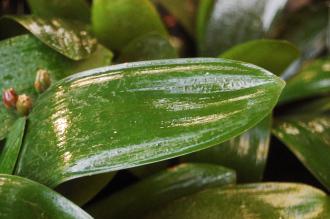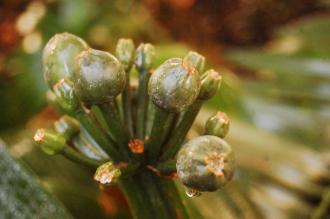
Clivia miniata (16/01/2016, Kew Gardens, London)
Position: Bright indirect light
Flowering period: Mostly spring
Soil: Moist, free drained
Eventual Height: 45cm
Eventual Spread: 30cm
Hardiness: 10a, 10b, 11, 12
Family: Amaryllidaceae
Clivia miniata is a frost tender evergreen perennial with a clump forming habit. Its dark green leaves are strap shaped with entire margins, up to 60cm long and 10cm across. Its yellow/ orange/ red flowers are up to 7cm long and appear as terminal umbles in groups of up to 20. Its fruit are spherical, initially green, maturing to red. Its roots form fleshy underground stems.

Clivia miniata Leaf (16/01/2016, Kew Gardens, London)
Clivia miniata, commonly known as Natal Lily, Bush Lily or Kaffer Lily, is native to South Africa. In its native habitat it grows as a woodland understory plant.
The etymological root of the binomial name Clivia is named after Lady Charlotte Clive (1787 – 1866), Duchess of Northumberland. Miniata is derived from the Latin miniatus menaing ‘scarlet’.
The landscape architect may find Clivia miniata useful as a foliage houseplant with attractive spring flowers suitable for bright light conditions.
Ecologically, Clivia miniata flowers are attractive to pollinating insects.

Clivia miniata Seed Pod (16/01/2016, Kew Gardens, London)
The Royal Horticultural Society have given Clivia miniata their prestigious Award of Garden Merit in 1993.
Clivia miniata prefers moist, fertile, free draining soils. It tolerates most pH of soil. This plant dislikes wet soils.
When maintaining Clivia miniata as a houseplant its soil should be watered thoroughly when the soil is dry to touch during the growing season. Watering should be reduced during the winter months. It requires a minimum temperature of 10ºc during the dormant period in order to flower well. Its preferred active growing temperature rages of between 18ºc to 24ºc. Once established feeding with weak solution should be carried out once a month after flowering to September. Large clumps may be divided. Mealybugs are a potential pest on this plant.

Landscape Architecture

